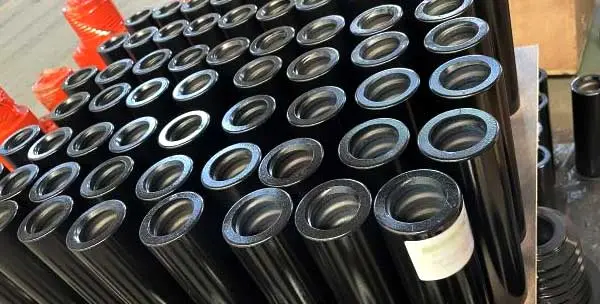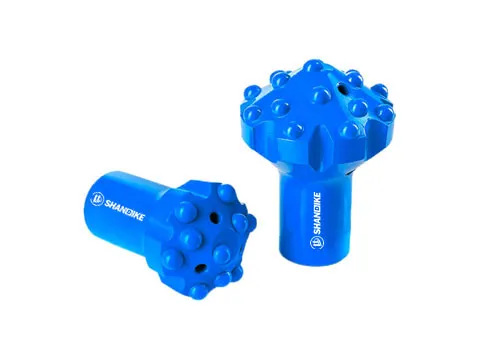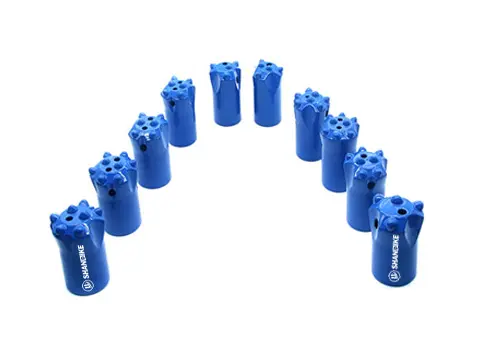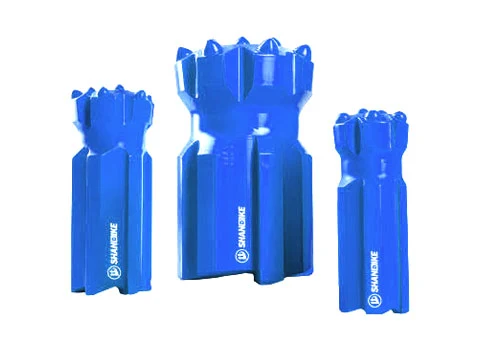Top Hammer coupling sleeves (or couplings) are critical components in percussive drilling systems, connecting drill rods to form a continuous drill string that transmits impact energy, rotation, and flushing medium (air/water). Here’s a breakdown of their key aspects:
 Function & Importance:
Function & Importance:
1. Connection: Securely join individual drill rods end-to-end.
2. Energy Transmission: Efficiently transfer high-frequency impact waves (from the top hammer) down the drill string to the bit.
3. Torque Transmission: Transfer rotation from the drill rig’s rotation head to the bit.
4. Flushing Medium Conduit: Provide a sealed pathway for compressed air/water to flush drill cuttings out of the hole.
5. Alignment: Maintain straightness and alignment of the drill string.
6. Wear Protection: Protect the threaded ends of the expensive drill rods from direct wear. Design & Key Features:
Design & Key Features:
1. Thread Type: Most common are R-threads (Robust Thread, defined by ISO 1718 standard). Key variants:
R32, R38, T38: Smaller diameters (common in exploration, bolting).
R32 Taper: Tapered thread version.
R25: Smaller, often for handheld drills.
T45, T51: Larger diameters for heavier drilling.
Crucial: Rods and couplings must match thread type and size exactly.
2. Material: Made from ultra-high-strength, tough alloy steels (e.g., 30CrNiMo, 34CrNiMo6, 42CrMo) through precise forging and machining. Heat treatment (quenching & tempering) achieves optimal hardness (typically HRC 28-35) balancing wear resistance and toughness to withstand impact fatigue.
3. Internal Threads: Both ends are threaded internally to match the external threads on the rod ends. Thread geometry is critical for energy transmission and fatigue life.
4. Sealing: Precision machining ensures a tight seal between the coupling face and the rod shoulder to prevent leakage of flushing air/water.
5. Shoulders: Mating shoulders on the coupling and rod provide axial alignment and transmit thrust/compressive loads.
6. External Surface: Often hexagonal or fluted to provide grip for wrenching during make-up/break-out.
7. Integral vs. Threaded Couplings:
Threaded Coupling Sleeves: Separate components screwed onto the rod ends (most common for top hammer).
Integral Couplings: The coupling thread is machined directly onto the end of the drill rod itself (more common in DTH systems).
Selection Criteria:
1. Drill Rod Size/Thread: Must perfectly match the rod diameter and thread type (e.g., R32, T38).
2. Application & Rig Size: Heavier drilling (large diameter, deep holes, hard rock) requires larger, stronger couplings (T45, T51 vs. R32, R38).
3. Rock Conditions: Abrasive rock demands higher wear resistance. Hard, brittle rock requires higher toughness.
4. Quality & Standards: Choose couplings from reputable manufacturers adhering to ISO 1718 (or equivalent) standards. Quality control is paramount for fatigue life and safety.
5. Compatibility: Ensure compatibility with the specific drill rig’s wrenching system (hex size).
Common Failure Modes & Prevention:
1. Thread Fatigue Failure (Cracking/Stripping): Caused by improper make-up torque, misalignment, worn threads, or exceeding fatigue life.
Prevention: Correct torque, inspect threads regularly, replace worn components, avoid overusing.
2. Wear (Thread & Shoulder): Gradual erosion from friction, rotation, and abrasive cuttings.
Prevention: Proper lubrication during make-up, use high-quality hardened couplings, ensure good flushing.
3. Cross-threading: Damages threads irreparably during make-up.
Prevention: Clean threads, start engagement carefully by hand, ensure alignment.
4. Shoulder Damage: Deformation or cracking due to excessive thrust or impact loads.
Prevention: Correct make-up torque, avoid excessive feed force.
5. Corrosion: Can accelerate wear and fatigue.
Prevention: Use appropriate steel grades, store properly, use corrosion inhibitors if needed.
Maintenance & Handling Best Practices:
1. Torque: Always use a calibrated torque wrench to achieve the correct make-up torque specified by the rod/coupling manufacturer. Under-torque causes fretting and fatigue; over-torque can stretch threads or damage shoulders.
2. Lubrication: Apply a high-pressure, high-temperature thread lubricant/grease specifically designed for drill steel every time before make-up. This reduces friction, prevents galling/seizing, and improves energy transmission.
3. Cleaning: Thoroughly clean threads and shoulders of dirt, grit, and old grease before applying new lubricant and making up the connection. Grit acts as an abrasive.
4. Inspection: Visually inspect threads and shoulders for wear, cracks, deformation, or corrosion before every use and during regular maintenance. Discard damaged components immediately. Use thread gauges.
5. Handling: Avoid dropping couplings. Protect threads from impact damage.
6. Rotation: Periodically rotate couplings on the rod (if using threaded sleeves) to distribute wear more evenly.
In essence, top hammer couplings are precision-engineered, high-stress components vital for efficient and safe drilling. Selecting the correct type, using proper make-up procedures with lubrication and torque, and rigorous inspection/maintenance are essential for maximizing drill string performance, minimizing downtime, and preventing costly failures or accidents.


